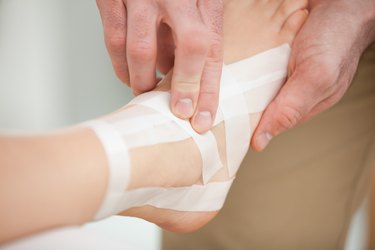
Moderate exercise is often recommended to help increase blood flow, strengthen muscles and bones, and promote overall health and well-being. Therefore, when you notice swelling after your workouts, it can be a cause of confusion and concern. Swelling, or edema, in the legs and ankles is not necessarily unusual, and it can be caused by a number of factors.
Ankle Swelling After Exercise
Video of the Day
If you experience swelling accompanied by pain, redness or difficulty bearing weight on your leg, seek medical attention for an accurate diagnosis.
Video of the Day
Increased Blood Flow
It's normal for parts of the body to swell during and after exercise. This phenomenon is associated with vasodilation. During exercise, the blood vessels open up to allow increased blood flow.
This can cause the hands, face, legs and feet to enlarge slightly and even appear swollen. Vasodilation typically reverses on its own after your body cools down.
Read more: What Causes a Person's Ankles to Swell?
Swelling and Hormones
Hormonal response can be responsible for swelling in some people, particularly women. According to the MedlinePlus, women who take estrogen supplements may be more prone to swelling. Pregnant people are also susceptible to swelling due to an overall increase in estrogen levels as well as increased blood volume and water retention throughout the body.
Because exercises, such as walking, jogging and hiking, encourage the natural effects of gravity, much of the body's fluids naturally pool in the lower legs, ankles and feet during physical activity and thus may result in swelling. However, this type of swelling is temporary.
Swelling From Injury
You may develop swelling if you have a previous injury that's not yet healed or you are recovering from a recent surgery of the legs or ankles. Stress fractures can also cause swelling. If you run or walk a great deal, inflammation in the joints due to arthritis or irritation from tendinitis or synovitis can also present as swollen ankles.
Organ Failure Edema
Although swelling of the legs and feet can be a sign of organ failure, it's not likely, particularly if the swelling only occurs following a workout. In cases of heart, liver or kidney failure, the organ typically fails in its responsibility to cycle fluids throughout the body. These excess fluids then create edema that can manifest as swollen ankles, hands and feet. For safety's sake, check with your doctor if you have any concerns.
Remedies for Swelling
If you've ruled out organ failure and injury as possible causes of your ankle swelling after exercise, you need not be alarmed as long as the swelling is manageable and subsides after a few hours. If your ankles do not return to normal size, you should consider taking a rest from your workout routine to allow time for healing.
You can also apply ice to the affected area, or soak your feet and ankles in a bath of ice water and Epsom salts. Consider getting fitted for proper athletic shoes with a reputable shoe outfitter as well. Properly fitting shoes can help ensure your gait is steady and less prone to injury.
Read more: How to Relieve Ankle Swelling Naturally